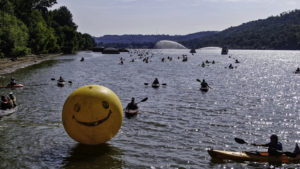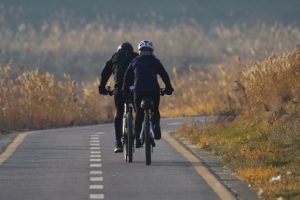When the United States barely lay claim to land west of the Mississippi river, Meriwether Lewis and William Clark traveled west to explore, study, and document a new section of land acquired under President Thomas Jefferson. While the Corps of Discovery’s expedition took years, the same route stands today and is as accessible and explorable as ever. In this blog, we invite you to explore the Lewis and Clark National Historic Trail with us!
Now maintained by the National Parks Service, the Lewis and Clark National Historic Trail stretches 4,900 miles from Pennsylvania all the way to the Pacific Ocean in Oregon. Along the trail lay thousands of museums, parks, historic sites, and much more. Whether you prefer the Native American history of the Great Plains in South Dakota or the peaceful hiking of the Rockies in Montana, you’ll find something you love along the original path of Lewis and Clark.
A great resource for exploring the trail is the Lewis and Clark Travel Experience’s interactive map, which allows you to zoom in and find different things to do along the trail. While the possibilities for recreation, and adventure are seemingly endless along the trail, here are a few different ideas on how to explore the West just like how Lewis and Clark did:
Explore the Lewis and Clark National Historic Trail through camping
As you could imagine, the crew along the Lewis and Clark Expedition couldn’t just grab an AirBnB for the night when things got cold. Instead, the Corps of Discovery relied on camping along its journey — and with how popular camping still is today, it’s hard to go wrong with this tried and true method of exploration. Here are some of the closest campsites to the original journey in each state along the trail
- Pennsylvania: Raccoon Creek State Park is located west of Pittsburgh — nearly in Ohio — and features more than 7,500 acres of land fit with a massive lake for swimming, fishing, or kayaking. Don’t miss the Wildflower Reserve and make sure you take advantage of the tranquil campground.
- West Virginia: Keep heading west along the trail and country roads will take you home to Tomlinson Run State Park, which is seated along the Ohio River in the “panhandle” section of the Mountain State. This 1,400-acre park has the works: fishing, hiking, boating, swimming, and more. If you want a break from typical tent camping, yurt and cabin rentals are available as well.
- Ohio: If you head south on the Ohio River into the Buckeye state, you’ll come across the 791-acre Forked Run State Park, which is Appalachia to the core — you’ll basically be in West Virginia! Before you settle in for the night, make sure you check out the park’s 24-hole disc golf course.
- Kentucky: You aren’t going to go wrong camping in Big Bone Lick State Historic Site along the trail in Kentucky. Ice Age exhibits, a bison herd, and the Salt Springs make this an exciting stop. While you’re in the area, it wouldn’t be a bad idea to check out the stunning Mammoth Cave National Park — although it is off the trail.
- Indiana: Did you know there are waterfalls in Indiana? In fact, City Falls State Park, located near Madison, In., has something called the Four Falls Challenge — a hiking path that will take you four miles past four different waterfalls in the park. Check out the railroad tunnel and take advantage of both electric and non-electric campsites, t
 oo.
oo.
- Illinois: Fort Massac State Park is the place to be if you want to camp along the trail in Illinois. Overlooking the Ohio River, this 1,800-acre park has a great mix of history to learn about and natural areas to soak in. If hunting is your thing, you can obtain shooting permits in certain parts of the park as well.
- Missouri: The campground at Arrow Rock State Historic Site is right next to the historic J. Huston Tavern, which is the oldest operating restaurant on this side of the Mississippi River. Big Solder Lake is also nearby if you’re visiting during the summer months and want to cool off.
- Kansas: Located on the massive 11,000-acre Perry Lake, Perry State Park has a slew of campground options, including cabin rentals. The marshy area is complemented by 45 miles of hiking and horseback-riding trails, which will surely keep you busy during your stay.
- Nebraska: Located on the Missouri River, Indian Cave State Park has absolutely earned its “hidden gem” status along the trail. How does 3,000 acres of protected land sound? As the park’s name suggests, unique cave features are the main attractions, but don’t miss out on the beautiful footpath hiking trails, horseback routes, aquatic opportunities, and more.
- Iowa: The first state park in Iowa, Waubonsie State Park is our pick for camping in the Hawkeye State. Here you’ll get the full experience of the Loess Hills, which are soil formations created by a wind phenomenon and only exist in parts of the midwestern United States. We’d be remiss if we didn’t mention Iowa’s Lewis and Clark State Park, which features a full-size replica of the Corps of Discovery’s iconic keelboat.
- South Dakota: While it has more of a resort feel than some of the other sites on this list, Lewis and Clark Recreation Area is a popular spot in the state for a reason. Marinas, biking, horseshoes, archery, canoeing, birding, and much more will keep you occupied during your stay.
- North Dakota: Fort Abraham Lincoln State Park is the oldest state park in North Dakota and is certainly worth a visit. Enjoy views of both the Heart and Missouri rivers while you pick from one of more than 100 cam
 psites along the water. It was here that Lewis and Clark first met the Mandan Indian tribes, which still have visible earthlodges today — making this spot a great stop for history geeks too.
psites along the water. It was here that Lewis and Clark first met the Mandan Indian tribes, which still have visible earthlodges today — making this spot a great stop for history geeks too.
- Montana: Lewis and Clark Caverns State Park is one of the most unique spots to stop and camp along the trail. This spot features one of the largest limestone caverns in the Northwest. While the underground portion of this park is the main driver, you’re going to want to take some time soaking in sunlight on the surface as well. Beautiful mountain vistas and wildlife spotting opportunities provide some of the best recreation activities the Big Sky State has to offer.
- Idaho: Our pick for Idaho was pretty easy: you’re going to want to check out Nez Perce-Clearwater National Forest, which features more than 4 million acres of wild terrain, rugged canyons, and cedar forests. This spot is beautiful all year round and features three different rivers to explore.
- Oregon: Right at the convergence of the Deschutes and Columbia rivers, you’ll find Deschutes River State Recreation Area along the trail. Lewis and Clark made it to this area in 1805, but you can find all sorts of recreation activities — both wet and dry — at this site today.
- Washington: Beacon Rock State Park, which is considered a year-round camping park, features a 4,400-acre area and the crown jewel: Beacon Rock, a beautiful geological feature with a thrilling hiking trail. The climb to the top of the trail was originally pioneered by Lewis and Clark themselves.
Water Adventures along the Lewis and Clark Trail
Since Lewis and Clark used a keelboat as their main method of transportation, you can’t go wrong enjoying some of the water trails available along the trail.
- Ohio River Recreation Trail: Follow this 274-mil
 e trail along the Ohio River from Portsmouth, Ohio, to Louisville, Kentucky, either by land or by water. This is the path Clark traveled to originally join forces with Lewis.
e trail along the Ohio River from Portsmouth, Ohio, to Louisville, Kentucky, either by land or by water. This is the path Clark traveled to originally join forces with Lewis.
- Missouri River Water Trail: Stay in a river town or set up shop in a tent along the 550-mile Missouri River Water Trail. This adventure will take you from Sioux City, Iowa, to Pickstown, South Dakota.
- Jefferson River Canoe Trail: This 80-mile journey along the Jefferson River was crucial to the Corps of Discovery. The entire river features Class I rapids, which makes it very easy for beginners to navigate. Campsites are abundant along the trail.
- Northwest Discovery Water Trail: This 367-mile trail covers the Clearwater, Snake, and Columbia Rivers along the path of Lewis and Clark. The vistas and camping opportunities along this waterway are incredibly enticing for anyone looking for an aquatic adventure.
Cycling along the LCNHT
While cycling would not have been a popular option among the Corps of Discovery, it’s an attractive option for folks looking to explore the Lewis and Clark National Historic Trail today.
The Adventure Cycling Association pioneered a 3,500-mile cycling rout
e that follows in the footprint of Lewis and Clark Trail that Lewis and Clark B

icycle Trail National Coordinator Michael McCoy says is “perfectly suited to exploring the landscapes and mindscapes of the Lewis and Clark expedition.”
If you’re an athlete up for a really big adventure, you’ll head from Hartford, Illinois, out west all the way to Glendive, Montana. The entire trail is very well paved and mapped, only featuring 174 miles of unpaved rail trails and 177.7 miles of gravel. You’ll climb
from sea level up to as high as 7,375 feet of elevation.
Auto Route – Drive the Lewis and Clark Trail!
Interest in an auto vehicle route along the path of Lewis and Clark’s journey began as early as the 1920s. In 1965, the Lewis and Clark Trail Commission approved an official marker for the Lewis and Clark Trail highway.
The original auto route featured a system of more than 6,100 miles of roads as of 2016, which has since been expanded eastward to Pittsburgh. You can view the whole auto trail here.
We hope you enjoyed learning about how to Explore the Lewis and Clark National Historic Trail. There are so many things to do, depending on your interests and passions. We encourage you to get out there and explore the trail!
